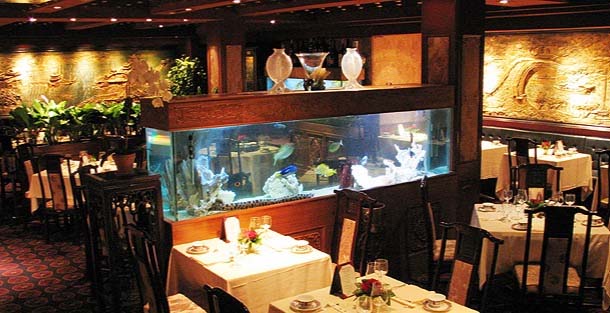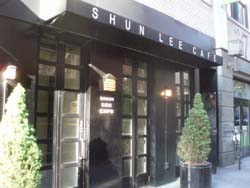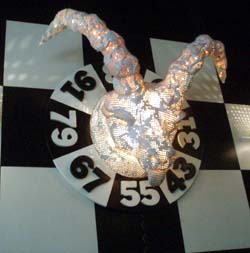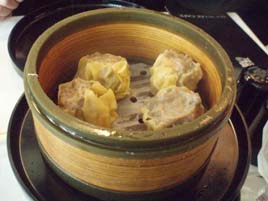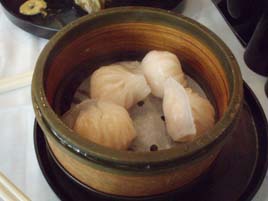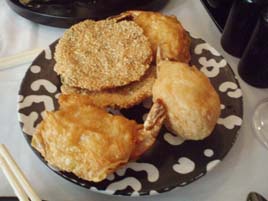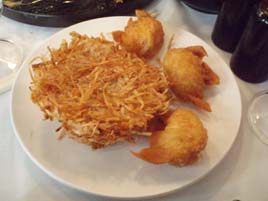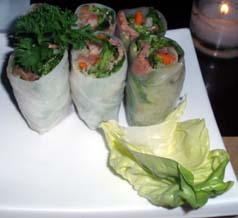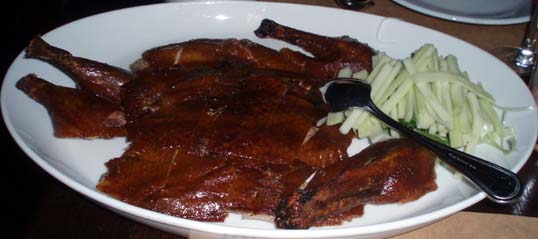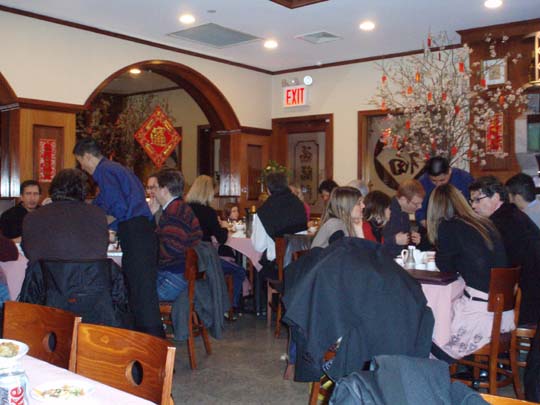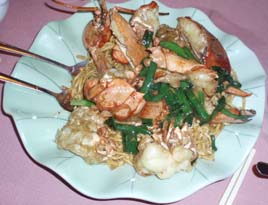
Note: Shang closed in October 2011. As of April 2012, the space is Blue Ribbon Sushi Izakaya.
*
New York is often unkind to imported chefs. New York’s Adam Platt, the city’s most clueless critic, once declared, “If I were them, and I had a successful restaurant elsewhere, I would not come.”
True enough, there have been some well publicized flops, especially where the itinerant chef is not in permanent residence: Lonesome Dove, anyone? Alain Ducasse has failed twice here, and at two current restaurants (Adour and Benoit) he has brought in new chefs after less than a year in business. Yet, had Thomas Keller and Joël Robuchon followed Platt’s advice, we would not have the exquisite Per Se or the sublime L’Atelier de Joël Robuchon.
 Still, these are tough waters to navigate. So it took a dash of audacity for Susur Lee to close his internationally acclaimed Toronto restaurant, Susur, and open Shang on Manhattan’s Lower East Side. Like those other chefs, Lee won’t be here full time (he still has another restaurant in Toronto), though he is a partner at Shang and presumably has a lot riding on its success.
Still, these are tough waters to navigate. So it took a dash of audacity for Susur Lee to close his internationally acclaimed Toronto restaurant, Susur, and open Shang on Manhattan’s Lower East Side. Like those other chefs, Lee won’t be here full time (he still has another restaurant in Toronto), though he is a partner at Shang and presumably has a lot riding on its success.
In Toronto, Lee was best known for his “reverse degustation” tasting menu, which “began with robust, heavier dishes and grew progressively lighter as the evening went on.” At Shang, he wisely chooses not to demand that kind of commitment. He offers instead an à la carte menu of tasting plates, most of them (except the soups) suitable for sharing.
The menu has 35 items in various categories, priced $3–29, but most are from $13–20. The “small plates” format is notoriously prone to upselling and over-ordering, but the server’s recommendation of four to six dishes for two people was exactly right—we settled on five, plus a half-order of bread, for a total of $88.50, which is remarkable for food this good.
Shang avoids other pitfalls often encountered at this type of restaurant. Sometimes, plates advertised for sharing are actually difficult to share—e.g., three sliders for two people. Here, every dish was evenly divisible by two. (One eGullet poster, though, was annoyed when Shang served six lamb chops for a party of seven. A server ought to have noticed that.)
 The other pitfall is timing. At some restaurants, the plates come out in crashing waves, drowning you in food you’re not yet ready to eat. You often wonder if the kitchen’s convenience has trumped the diner’s. Here too, the staff got it just right. We started with a salad—the immense Singapore Slaw ($16; right)—then two appetizers, and finally two main courses, all paced appropriately.
The other pitfall is timing. At some restaurants, the plates come out in crashing waves, drowning you in food you’re not yet ready to eat. You often wonder if the kitchen’s convenience has trumped the diner’s. Here too, the staff got it just right. We started with a salad—the immense Singapore Slaw ($16; right)—then two appetizers, and finally two main courses, all paced appropriately.
The service impressed us in other ways. Our first half-bottle of wine was slow to arrive. That shouldn’t happen, but the server handled it the right way: by telling the kitchen to slow down, so that we wouldn’t be drinking water with our appetizers.
 We asked for an order of the Whole Wheat Manto Bread ($3; left). Without prompting, the server offered to cut it down to a half-order, as a full portion is more than two people would normally eat. We certainly had no way of knowing this, and many servers wouldn’t be alert enough (or honest enough) to point it out.
We asked for an order of the Whole Wheat Manto Bread ($3; left). Without prompting, the server offered to cut it down to a half-order, as a full portion is more than two people would normally eat. We certainly had no way of knowing this, and many servers wouldn’t be alert enough (or honest enough) to point it out.
That Singapore Slaw comes in a volcano shape (there’s a photo on Gael Greene’s blog) before a server tosses its 19 ingredients tableside. I won’t try to describe the blizzard of flavors; you have to try it. The menu describes it as a portion for two, though four could easily share it.
The Mantou Bread is roasted to order, and the server warned it wouldn’t come out for about 20 minutes. It’s absolutely wonderful, but given that it’s only 37½ cents a slice, I wonder why the restaurant doesn’t just send out an order at the front end of every meal?


Chef Lee’s cuisine has been described as Chinese fusion. Everything we tasted was ablaze in flavor and impeccably prepared. Most of it you would find in no other restaurant.
Vegetable Potato Dumplings ($13; above left) wore a crusty cloak—yes, there are four individual dumplings on that plate. Lobster and Shrimp Croquettes ($18; above right) were in a delicate puffy jacket, each resting on a slow-cooked wedge of daikon.


Mongolian Lamb Chops ($20; above left) were as tender and flavorful as I’ve experienced in any restaurant lately, along with glazed bananas and a chili mint sauce. A cold carrot cardamom chutney would have been better omitted. A Young Garlic Chicken ($20; above right) yielded six pieces of plump meat, cooked perfectly.
I was pleased to see an ample selection of half-bottles of wine, an option far more restaurants should offer. It gave us the chance to sample two halves for a total of $41, less than we normally pay for a full bottle. (Now that I look back on it, I think they charged us less for the wine than the prices listed.)
Though Shang is a casual restaurant, the service team would be at home in a more formal setting. Fresh plates and silverware, and extra serving utensils, are provided for each course. Chopsticks are enamel, rather than the disposable wood most places use. Even the starched white napkins are delivered with a flourish.
Some glitches still need to be worked out. The large bar area was practically deserted. Yet, when I asked for a cocktail list, the inattentive and seemingly bored bartender gave me the bottle service list instead, which listed only two cocktails. Only when we got to the table did we realize the restaurant offers a dozen others. Our bar tab was not transferrable to the dining room.
The dining room itself was about 25 percent full when we arrived at 7:00 p.m. on a Friday evening, and about 75 percent full when we left. That’s probably not as good as they’d like, though not bad in a neighborhood that doesn’t come alive till late.
Shang is located in a luxury boutique hotel, the Thompson LES. The space is as gorgeous as it is comfortable. If you’ve been around a while, you have to pinch yourself before you believe you’re at the formerly desolate corner of Houston and Allen Streets. The restaurant’s advertised address—a separate entrance on Orchard Street—is not yet open. You get there via the hotel entrance on Allen Street.
No restaurant opening today can be assured of success, but if Chef Lee keeps his eye on the kitchen, Shang should do very well indeed.
Shang (187 Orchard Street between Houston & Stanton Streets, Lower East Side)
Food: **
Service: **
Ambiance: **
Overall: **
 Saturday, April 25, 2009 at 02:11PM
Saturday, April 25, 2009 at 02:11PM  A couple of weeks ago, we headed down to the Peking Duck House for—well, you can probably guess.
A couple of weeks ago, we headed down to the Peking Duck House for—well, you can probably guess.






 After the superb duck, the entrées (above) seemed almost superfluous. It would probably be better if they were served separately, but as the restaurant wants to turn tables, they were served at the same time as the duck, which made for an awfully crowded table. A dessert of fresh sliced fruit (left) went barely touched.
After the superb duck, the entrées (above) seemed almost superfluous. It would probably be better if they were served separately, but as the restaurant wants to turn tables, they were served at the same time as the duck, which made for an awfully crowded table. A dessert of fresh sliced fruit (left) went barely touched.


